
The documentation set for this product strives to use bias-free language. For the purposes of this documentation set, bias-free is defined as language that does not imply discrimination based on age, disability, gender, racial identity, ethnic identity, sexual orientation, socioeconomic status, and intersectionality. Exceptions may be present in the documentation due to language that is hardcoded in the user interfaces of the product software, language used based on RFP documentation, or language that is used by a referenced third-party product. Learn more about how Cisco is using Inclusive Language.
A list of supported software can be found in Supported VPN Platforms, Cisco ASA 5500 Series.
Ensure that you meet these requirements before you attempt this configuration:
The full list of requirements can be found in Supported VPN Platforms, Cisco ASA 5500 Series.
The information in this document is based on these software and hardware versions:
The information in this document was created from the devices in a specific lab environment. All the devices used in this document began with a cleared (default) configuration. If your network is live, make sure that you understand the potential impact of any command.
This article describes the configuration process for both the ASDM and the CLI. You can choose to follow either of the tools in order to configure the WebVPN, but some of the configuration steps can only be achieved with the ASDM.
Note: Use the Command Lookup Tool (registered customers only) to obtain more information about the commands used in this section.
This document uses this network setup:

WebVPN uses the SSL protocol in order to secure the data transferred between the client and the server. When the browser initiates a connection to the ASA, the ASA presents its certificate to authenticate itself to the browser. In order to ensure that the connection between the client and the ASA is secure, you need to provide the ASA with the certificate that is signed by the Certificate Authority that the client already trusts. Otherwise the client will not have the means to verify authenticity of the ASA which results in the possibility of the man-in-the-middle attack and poor user experience, because the browser produces a warning that the connection is not trusted.
Note: By default, the ASA generates a self-signed X.509 certificate upon startup. This certificate is used in order to serve client connections by default. It is not recommended to use this certificate because its authenticity cannot be verified by the browser. Furthermore, this certificate is regenerated upon each reboot so it changes after each reboot.
Certificate installation is out of the scope of this document.
Configure the WebVPN on the ASA with five major steps:
Note: In ASA releases later than Release 9.4, the algorithm used to choose SSL ciphers has been changed (see Release Notes for the Cisco ASA Series, 9.4(x)).If only elliptic curve-capable clients will be used, then it is safe to use elliptic curve private key for the certificate. Otherwise the custom cipher suite should be used in order to avoid having the ASA present a self-signed temporary certificate. You can configure the ASA to use only RSA-based ciphers with the ssl cipher tlsv1.2 custom "AES256-SHA:AES128-SHA:DHE-RSA-AES256-SHA:DHE-RSA-AES128-SHA:DES-CBC3-SHA:DES-CBC-SHA:RC4-SHA:RC4-MD5" command.
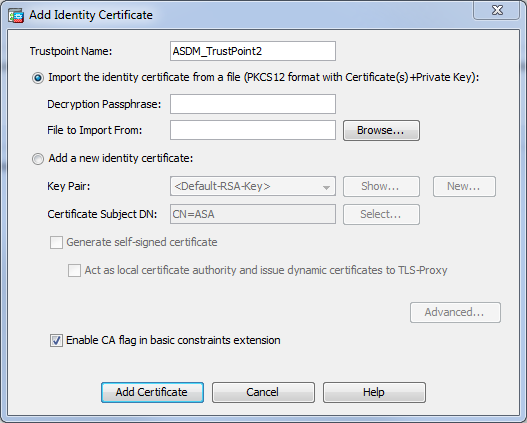
ASA(config)# crypto ca import TrustPoint-name pkcs12 "password"
Enter the base 64 encoded pkcs12.
End with the word "quit" on a line by itself:
MIIJUQIBAzCCCRcGCSqGSIb3DQEHAaCCCQgEggkEMIIJADCCBf8GCSqGSIb3DQEH
BqCCBfAwggXsAgEAMIIF5QYJKoZIhvcNAQcBMBwGCiqGSIb3DQEMAQYwDgQI8F3N
+vkvjUgCAggAgIIFuHFrV6enVflNv3sBByB/yZswhELY5KpeALbXhfrFDpLNncAB
z3xMfg6JkLYR6Fag1KjShg+o4qkDh8r9y9GQpaBt8x3Ozo0JJxSAafmTWqDOEOS/
7mHsaKMoao+pv2LqKTWh0O7No4Ycx75Y5sOhyuQGPhLJRdionbi1s1ioe4Dplx1b
--- output ommited ---
Enter the base 64 encoded pkcs12.
End with the word "quit" on a line by itself:
MIIJUQIBAzCCCRcGCSqGSIb3DQEHAaCCCQgEggkEMIIJADCCBf8GCSqGSIb3DQEH
BqCCBfAwggXsAgEAMIIF5QYJKoZIhvcNAQcBMBwGCiqGSIb3DQEMAQYwDgQI8F3N
+vkvjUgCAggAgIIFuHFrV6enVflNv3sBByB/yZswhELY5KpeALbXhfrFDpLNncAB
z3xMfg6JkLYR6Fag1KjShg+o4qkDh8r9y9GQpaBt8x3Ozo0JJxSAafmTWqDOEOS/
7mHsaKMoao+pv2LqKTWh0O7No4Ycx75Y5sOhyuQGPhLJRdionbi1s1ioe4Dplx1b
quit
INFO: Import PKCS12 operation completed successfully
Option 2 - Create a self-signed certificate. Choose Configuration > Firewall > Advanced > Certificate Management > Identity Certificates > Add. Click the Add a new identity certificate radio button. Check the Generate self-signed certificate check box. Choose a Common Name (CN) that matches domain name of the ASA.  Click New in order to create the keypair for the certificate. Choose the Key Type, Name, and Size.
Click New in order to create the keypair for the certificate. Choose the Key Type, Name, and Size. 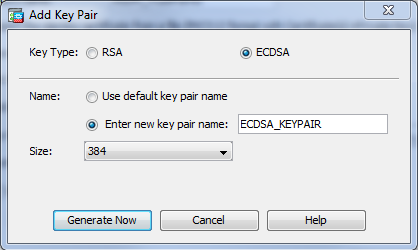 CLI:
CLI:
ASA(config)# crypto key generate ecdsa label ECDSA_KEYPAIR noconfirm
ASA(config)# crypto ca trustpoint TrustPoint1
ASA(config-ca-trustpoint)# revocation-check none
ASA(config-ca-trustpoint)# id-usage ssl-ipsec
ASA(config-ca-trustpoint)# no fqdn
ASA(config-ca-trustpoint)# subject-name CN=ASA
ASA(config-ca-trustpoint)# enrollment self
ASA(config-ca-trustpoint)# keypair ECDSA_KEYPAIR
ASA(config-ca-trustpoint)# exit
ASA(config)# crypto ca enroll TrustPoint1 noconfirm
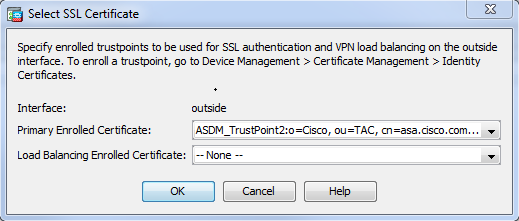
Choose the certificate that will be used to serve WebVPN connections. Choose Configuration > Remote Access VPN > Advanced > SSL Settings. From the Certificates menu, choose the trustpoint associated with the desired certificate for the outside interface. Click apply. Equivalent CLI configuration:
ASA(config)# ssl trust-point outside
(Optional) Enable Domain Name Server (DNS) lookups. WebVPN server acts as a proxy for client connections. It means that the ASA creates connections to the resources on behalf of the client. If the clients require connections to the resources that use domain names, then the ASA needs to perform the DNS lookup. Choose Configuration > Remote Access VPN > DNS. Configure at least one DNS server and enable DNS lookups on the interface that faces the DNS server. 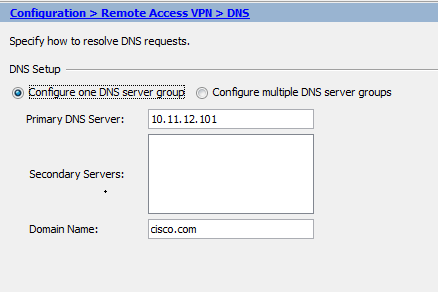
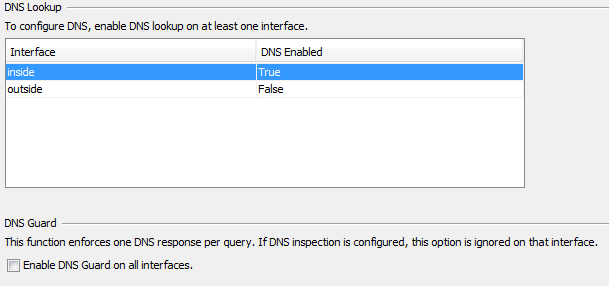 CLI:
CLI:
ASA(config)# dns domain-lookup inside
ASA(config)# dns server-group DefaultDNS
ASA(config-dns-server-group)# name-server 10.11.12.101
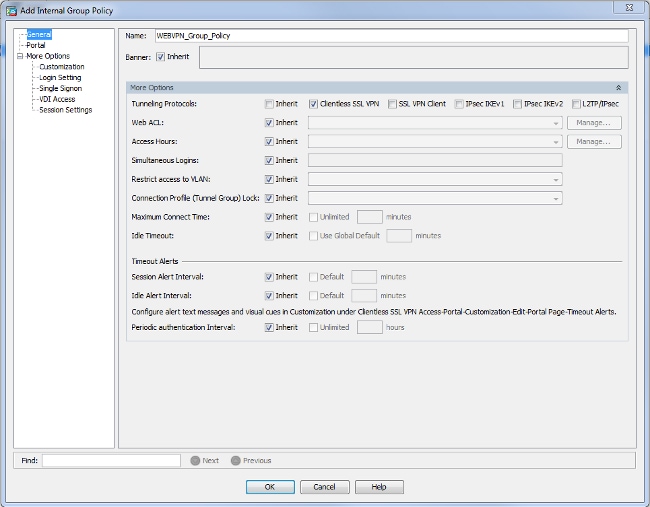
(Optional) Create Group Policy for WEBVPN connections. Choose Configuration > Remote Access VPN > Clientless SSL VPN Access > Group Policies > Add Internal Group Policy. Under General Options change the Tunelling Protocols value to "Clientless SSL VPN". CLI:
ASA(config)# group-policy WEBVPN_Group_Policy internal
ASA(config)# group-policy WEBVPN_Group_Policy attributes
ASA(config-group-policy)# vpn-tunnel-protocol ssl-clientless
- Users can manually select the connection profile from the drop-down list or with a specific URL. See ASA 8.x: Allow Users to Select a Group at WebVPN Login via Group-Alias and Group-URL Method.
- When you use an LDAP server, you can assign the user profile based on the attributes received from the LDAP server, see ASA Use of LDAP Attribute Maps Configuration Example.
- When you use certificate-based authentication of the clients, you can map the user to the profiles based on the fields contained in the certificate, see Cisco ASA Series VPN CLI Configuration Guide, 9.4 - Configure Certificate Group Matching for IKEv1.

- In order to assign the users manually to the Group policy, see Cisco ASA Series VPN CLI Configuration Guide, 9.4 - Configuring Attributes for Individual Users Edit the DefaultWEBVPNGroup profile and choose the WEBVPN_Group_Policy under Default Group Policy. CLI:
ASA(config)# tunnel-group DefaultWEBVPNGroup general-attributes
ASA(config-tunnel-general)# default-group-policy WEBVPN_Group_Policy
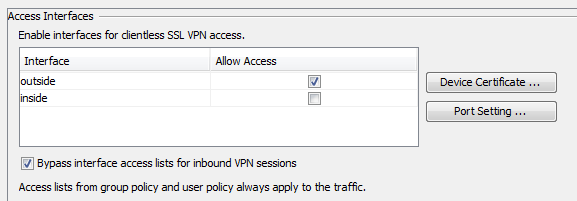
In order to enable the WebVPN on the outside interface, choose Configuration > Remote Access VPN > Clientless SSL VPN Access > Connection Profiles. Check the Allow Access checkbox next to the outside interface. CLI:
ASA(config)# webvpn
ASA(config-webvpn)# enable outside
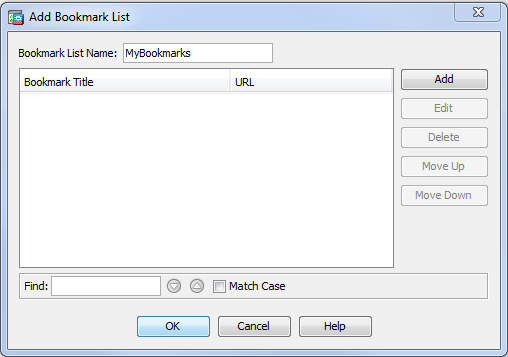 Choose Add in order to add a specific bookmark.
Choose Add in order to add a specific bookmark.  CLI: It is impossible to create bookmarks via the CLI because they are created as XML files.
CLI: It is impossible to create bookmarks via the CLI because they are created as XML files.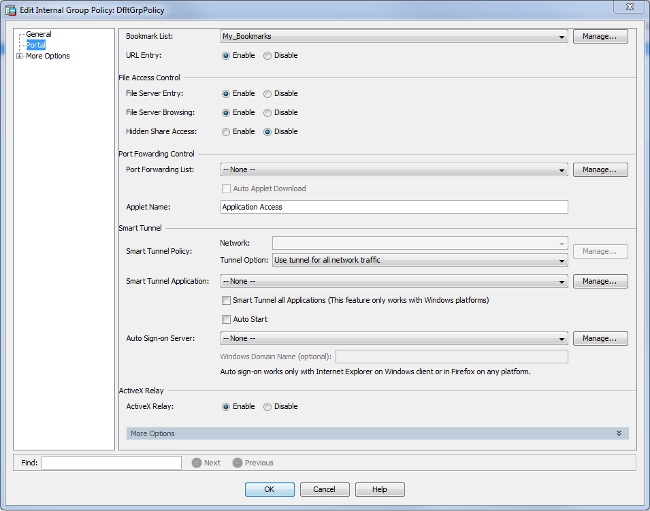 CLI:
CLI:
ASA(config)# group-policy DfltGrpPolicy attributes
ASA(config-group-policy)# webvpn
ASA(config-group-webvpn)# url-list value My_Bookmarks
Once the WebVPN has been configured, use the address https://FQDN of the ASA> in the browser.

After logging in you should be able to see the address bar used to navigate to websites and the bookmarks.

Follow these instructions in order to troubleshoot your configuration.
In ASDM, choose Monitoring > Logging > Real-time Log Viewer > View. When a client connects to the ASA, note the establishment of TLS session, selection of group policy, and successful authentication of the user.
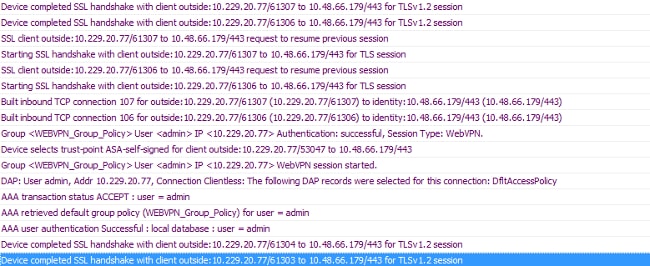
ASA(config)# logging buffered debugging
ASA(config)# show logging
In ASDM, choose Monitoring > VPN > VPN Statistics > Sessions > Filter by: Clientless SSL VPN. Look for the new WebVPN session. Be sure to choose the WebVPN filter and click Filter. If a problem occurs, temporarily bypass the ASA device to ensure that clients can access the desired network resources. Review the configuration steps listed in this document.

ASA(config)# show vpn-sessiondb webvpn
Session Type: WebVPN
Username : admin Index : 3
Public IP : 10.229.20.77
Protocol : Clientless
License : AnyConnect Premium
Encryption : Clientless: (1)AES128 Hashing : Clientless: (1)SHA256
Bytes Tx : 72214 Bytes Rx : 270241
Group Policy : WEBVPN_Group_Policy Tunnel Group : DefaultWEBVPNGroup
Login Time : 10:40:04 UTC Tue May 26 2015
Duration : 0h:05m:21s
Inactivity : 0h:00m:00s
VLAN Mapping : N/A VLAN : none
Audt Sess ID : 0a1516010000300055644d84
Security Grp : none
The Output Interpreter Tool (registered customers only) (OIT) supports certain show commands. Use the OIT to view an analysis of show command output.
Note: Refer to Important Information on Debug Commands before you use debug commands.
Problem
The message "Clientless (browser) SSL VPN access is not allowed." appears in the browser after an unsuccessful login attempt. The AnyConnect Premium license is not installed on the ASA or it is not in use as shown by "Premium AnyConnect license is not enabled on the ASA."
Solution
Enable the Premium AnyConnect license with these commands:
ASA(config)# webvpn
ASA(config-webvpn)# no anyconnect-essentials
Problem
The message "Login failed" appears in the browser after an unsuccessful login attempt. The AnyConnect license limit has been exceeded.
Solution
Look for this message in the logs:
%ASA-4-716023: Group User IP
Session could not be established: session limit of 2 reached.
Also, verify your license limit:
ASA(config)# show version | include Premium
AnyConnect Premium Peers : 2 perpetual
Problem
The message "AnyConnect is not enabled on the VPN server" appears in the browser after an unsuccessful login attempt. Clientless VPN protocol is not enabled in the group-policy.
Solution
Look for this message in the logs:
%ASA-6-716002: Group User IP
WebVPN session terminated: Client type not supported.
Make sure that Clientless VPN protocol is enabled for the desired group-policy:
ASA(config)# show run all group-policy | include vpn-tunnel-protocol
vpn-tunnel-protocol ikev1 ikev2 l2tp-ipsec ssl-clientless
Problem
Only three WebVPN clients can connect to the ASA. The connection for the fourth client fails.
Solution
In most cases, this issue is related to a simultaneous login setting within the group policy. Use this illustration in order to configure the desired number of simultaneous logins. In this example, the desired value is 20.
ASA(config)# group-policy Cisco attributes
ASA(config-group-policy)# vpn-simultaneous-logins 20
Problem
If these bookmarks were configured for users to sign in to the clientless VPN, but on the home screen under "Web Applications" they show up as grayed out, how can I enable these HTTP links so that the users are able to click them and go into the particular URL?
Solution
You should first make sure that the ASA can resolve the websites through DNS. Try to ping the websites by name. If the ASA cannot resolve the name, the link is grayed out. If the DNS servers are internal to your network, configure the DNS domain-lookup private interface.
Problem
The error message "the ica client received a corrupt ica file." occurs for Citrix over WebVPN.
Solution
If you use the secure gateway mode for Citrix connection through WebVPN, the ICA file can corrupt. Because the ASA is not compatible with this mode of operation, create a new ICA file in the Direct Mode (non-secure mode).
Problem
When you access CIFS links on the clientless WebVPN portal, you are prompted for credentials after you click the bookmark. Lightweight Directory Access Protocol (LDAP) is used in order to authenticate both the resources and the users already have entered LDAP credentials to log in to the VPN session.
Solution
You can use the auto-signon feature in this case. Under the specific group-policy being used and under its WebVPN attributes, configure this:
ASA(config)# group-policy WEBVPN_Group_Policy attributes
ASA(config-group-policy)# webvpn
ASA(config-group-webvpn)# auto-signon allow uri cifs://X.X.X.X/* auth-type all
where X.X.X.X=IP of the CIFS server and *=rest of the path to reach the share file/folder in question.
An example configuration snippet is shown here:
ASA(config)# group-policy ExamplePolicy attributes
ASA(config-group-policy)# webvpn
ASA(config-group-webvpn)# auto-signon allow uri
https://*.example.com/* auth-type all